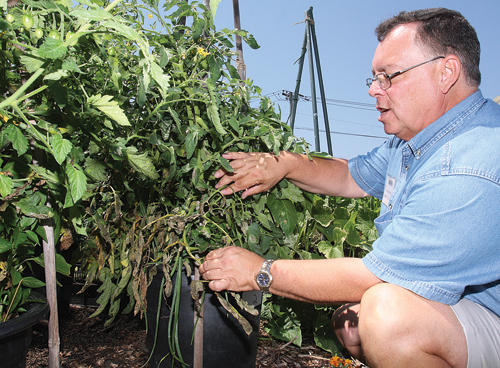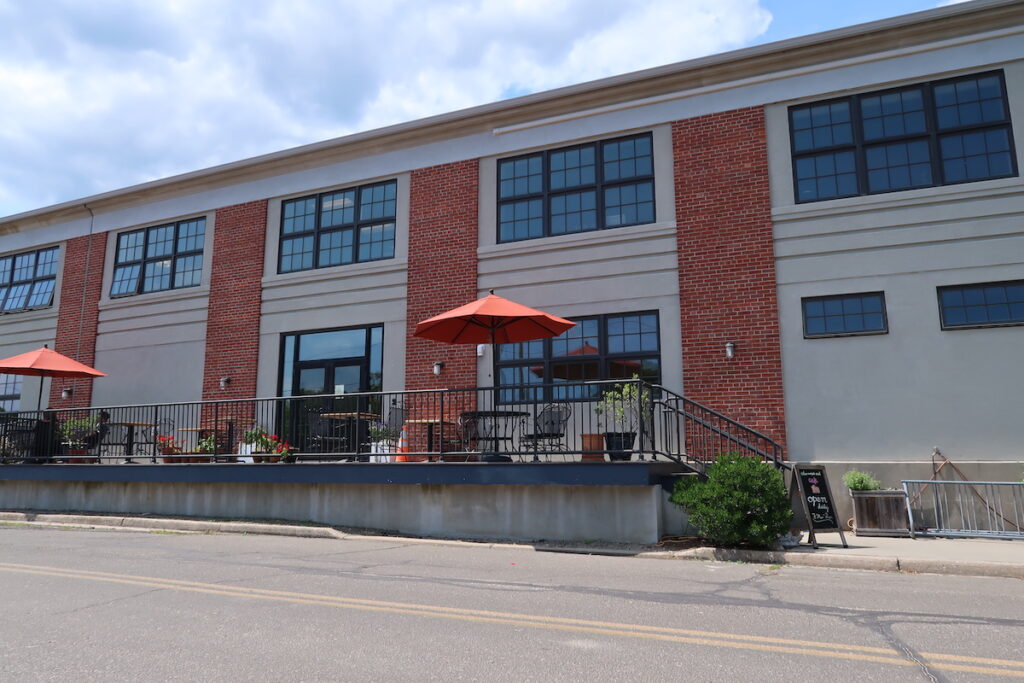Gardeners learn how to wage war on plant diseases

The memory of last year’s late-blight outbreak, which attacked tomatoes and potatoes, is still fresh in the minds of many backyard vegetable gardeners as they prepare to set their plants out this growing season.
But plant doctor Meg McGrath, a Cornell University professor of plant pathology and plant microbe biology at the Cornell Cooperative Extension in Riverhead, has some new online tools to help gardeners monitor whether late blight and other spore-borne diseases are heading their way.
At a forum at CCE’s Riverhead headquarters Tuesday night, she helped members of local community gardens understand how to keep their gardens disease-free.
Ms. McGrath urged gardeners not to plant potatoes in their home gardens, since late blight needs living host tissue to overwinter in garden soil. Although the disease can devastate tomato crops, she said, it doesn’t affect their seeds in the ground in winter. But it can overwinter in potato tubers mistakenly left in the ground.
“My analogy for growing potatoes in the home garden is it’s like playing Russian roulette,” she said. “You never know if they’re infected, even if you use certified seed potatoes.”
One of the best — or worst — ways to encourage late blight, she said, is to plant the eyes of potatoes bought at the grocery store, which were probably not monitored for disease before being sold.
Home gardeners should always be on the alert for late blight on their tomatoes, she said, since the disease has been an ever-increasing common occurrence on Long Island in the past three years.
The symptoms begin with large, irregular greenish-gray spots on leaves, which turn brown and then begin to develop a white mold on the underside. In later stages of the disease, large brown areas appear on the stems and the fruit begins to rot.
As soon as gardeners think they have late blight, she said, they should call Cornell Cooperative Extension, which can analyze the fungus, determine if it’s late blight and make the public aware of the outbreak.
CCE is participating in a national online project which shows gardeners where late blight has appeared in the U.S. and where it can be expected to move.
She said the spores can travel as much as 30 miles if the infected plants are not detected and destroyed early enough.
Unlike human diseases, she said, plant diseases can’t be cured, they can only be managed. She recommended that gardeners use trellises and plant their crops far enough apart to ensure air circulation between plants, making the conditions less favorable for funguses to grow.
She urged gardeners to adopt a “no tomato left behind” garden policy, picking up every tomato and disposing of the inedible ones, and to wash tools before bringing them to another garden patch.
Growers can spray copper-based fungicides, some of which are organic, at the very early stages of the disease, she said, but it is most effective when used as a preventive measure when gardeners know late blight is in their area but it hasn’t yet hit.
She said the biggest danger for crops will be if the late blight fungus develops the ability to reproduce sexually instead of through spores. That hasn’t happened in the United States, she said, but if it does the fungus will be able to live through the winter in the soil without a host plant.
The only saving grace with late blight, she said, is the relatively narrow range of plants it affects. Aside from potatoes and tomatoes, she said, it’s only been known to hit weeds in the nightshade family, tomatillos, and, in one freak year, petunias.
“We tended to have one or two strains that were very aggressive on potato,” she said. “Now we have a few tomato-liking strains.”
Many members of the River & Roots Community Garden in downtown Riverhead attended the seminar. They’ve urged gardeners there to not plant tomatoes this year after late blight hit their tomatoes last year.
They’re considering purchasing some late blight-resistant tomatoes, including Plum Regal, Mountain Magic and Lizzano cherry tomatoes and Defiant PHR and Legend beefsteak tomatoes.
Two other funguses that attack squashes, melons and cucumbers are also of major concern for local gardeners.
Downy mildew and the associated basil downy mildew are also dispersed by the wind over large areas, said Ms. McGrath. National downy mildew forecasts are available online.
Downy mildew is found on the underside of leaves, in spots that usually don’t cross over the veins in the leaves.
“This is one we’ve been seeing more often since 2005,” she said. “We see it now on Long Island every year.”
Powdery mildew, a white, powdery coating that usually attacks squashes and melons, is also very common, though relatively easy to manage if caught early, she said.
“It’s easiest to control with organic materials, mineral oils, potassium bicarbonate,” she said. “A lot of products will stop it.”
Unlike late blight, “you don’t need to tell the rest of the world you have it,” she said.







